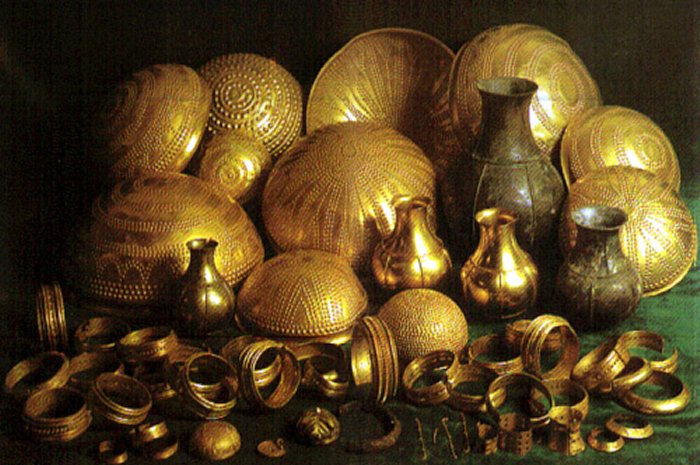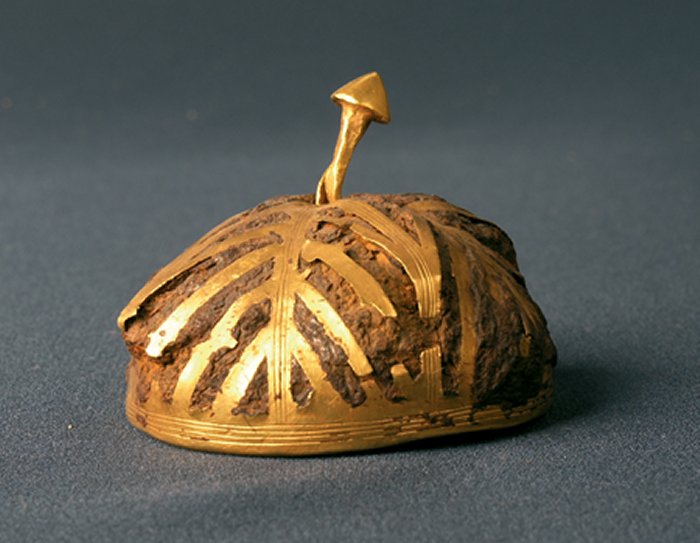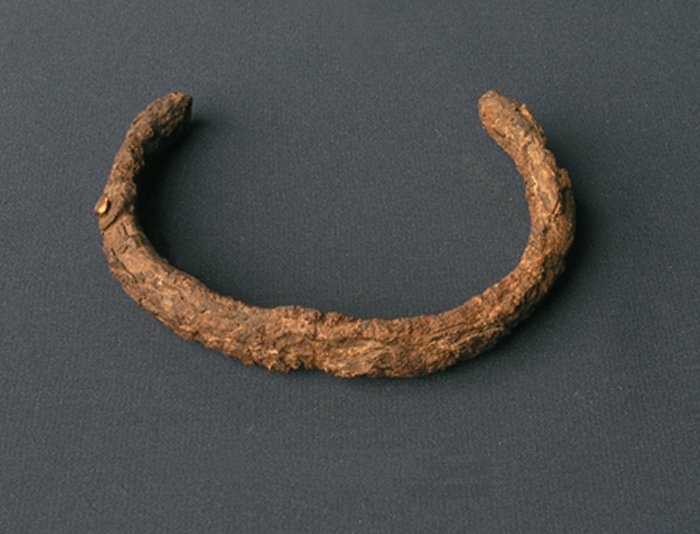Jan Bartek – AncientPages.com – The beautiful Treasure of Villenna was discovered in 1963 by archaeologist José María Soler in the sands of a dry riverbed in Villena, in the province of Alicante, Spain.
Identified as the most significant discovery of gold from the European Bronze Age, this 3,000-year-old treasure consists of 59 items crafted from gold, silver, iron, and amber. It holds paramount importance in terms of prehistoric gold finds in the Iberian Peninsula and ranks second in Europe, only surpᴀssed by the Royal Graves located in Mycenae, Greece.

The whole Treasure of Villena. Credit: © Enrique Íñiguez Rodríguez – CC BY-SA 3.0
A new analysis of the Treasure of Villenna reveals some of its iron artifacts: a hollow C-shaped bracelet covered in a sheet of gold and an open bracelet made of meteoric iron. According to the study published in the journal Trabajos de Prehistoria, people on the Iberian Peninsula created objects with metal from a meteorite that crashed onto our planet one million years ago. Both the iron objects were dated to between 1,400 and 1,200 B.C.
Ignacio Montero Ruiz, the senior study author, pointed out that the technology used in ironworking was entirely distinct from copper-based metallurgy, which was prevalent for working with noble metals such as gold and silver during that era. This suggests that individuals who worked with meteoric iron had to innovate and develop new technology.
The Treasure of Villena, due to its extraordinary worth, is securely housed in an armored display case within the town’s archaeological museum. There has been ongoing debate among experts regarding its historical period. Some believe it belongs to the post-Argaric period, dating from 1,500 to 1,300 B.C., while others suggest it may be from the final phases of the Late Bronze Age around the 8th century B.C.

People used iron from a meteorite that hit the Earth one million years ago. Credit: Adobe Stock – Tryfonov
The recent study sheds new light on the remarkable ancient Treasure of Villenna, even if the researchers cannot yet determine who created the objects and where they came from. One interesting aspect of the study is the significant relationship between gold and iron, given their substantial symbolic and societal worth. In this instance, the Treasure of Villenna artifacts likely represent a concealed treasure that may have been community-owned rather than individual property. It’s noteworthy to mention that during this historical era, there were no established kingdoms on the Iberian Peninsula.
They are the first objects found in the Iberian Peninsula that were made with material from beyond planet Earth,” the scientists said. Ancient artifacts made from the metal of a meteorite have been encountered before. One of the most famous examples is King Tut’s cosmic dagger. The dagger, buried alongside Pharaoh Tutankhamun, was made from the metal of a meteorite. Italian and Egyptian researchers think the cosmic dagger was placed next to 18-year-old King Tut’s mummified body, presumably in the hope he could use it to protect himself in the afterlife.
King тιт also had a cosmic scarab brooch. The “scarab is one of the oldest and most widely used symbols of the ancient Egyptians. Egyptian pharaohs worshipped dung beetles.
Upon discovering King Tutankhamun’s tomb, archaeologist Howard Carter initially believed that the Pharaoh’s brooch was crafted from chalcedony, a variety of quartz. “
Today, scientists know the material known as Libyan Desert Silica Glᴀss was formed about 28 million years ago when a meteorite entered the Earth’s atmosphere and exploded over Egypt. This cosmic impact heated the sand beneath it to a temperature of about 2,000 degrees Celsius. 1
As a result of this, desert glᴀss was formed, and this material was later used to create King Tut’s scarab brooch.” 1
“The results of the analyses carried out on the iron pieces from the Villena hoard indicate with a high probability that they are objects made with meteoritic iron.

Hollow iron hemisphere covered with gold sheets. You can see how the corrosion of the iron has covered and deformed some gold sheets. Credit: Villena Museum (Alicante)

Iron bracelet from the Treasure of Villenna. Credit: Villena Museum (Alicante)
The available data suggests that the pommel and bracelet from the Villena hoard would currently be the first two pieces attributable to meteoritic iron in the Iberian Peninsula. This is compatible with a chronology of the Late Bronze Age [1,400-1,200 B.C.], prior to the beginning of widespread production using terrestrial iron. The chronology of abandonment of Cabezo Redondo [the other hoard related to that of Villena] dates back to before 1,200 B.C., and the relationships established between the two seem to be the best arguments to establish the chronology,” the research team writes in the study. 2
Written by Jan Bartek – AncientPages.com Staff Writer
Expand for references
- Jan Bartek – King Tut’s Cosmic Scarab Brooch And Dagger Linked To Meteorite’s Crash 28 Million Years Ago – AncientPages.com
- Rovira-Llorens, S. ., Renzi, M., & Montero Ruiz, I. (2023). Meteoritic iron in the Villena Treasure? Trabajos De Prehistoria, 80(2), e19. https://doi.org/10.3989/tp.2023.12333





